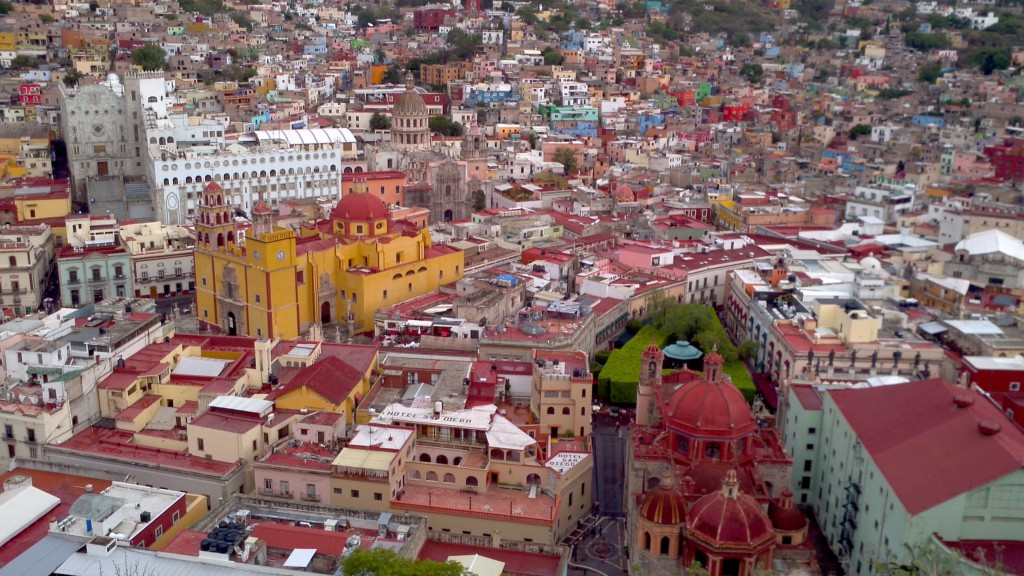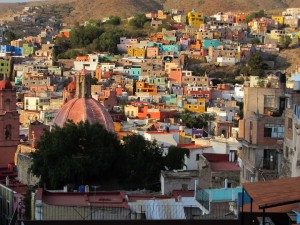 We spent our last month in Guanajuato, Mexico, up in the mountains north of Mexico City. The city is built in the 1500’s within the ravines of a few connecting dry riverbeds. We lived toward the top of a ridge above most of the town. Sounds were carried up into our home bouncing off the walls of ravines. And we heard the music of Mexico, music which didn’t stop. Truly, it didn’t stop.
We spent our last month in Guanajuato, Mexico, up in the mountains north of Mexico City. The city is built in the 1500’s within the ravines of a few connecting dry riverbeds. We lived toward the top of a ridge above most of the town. Sounds were carried up into our home bouncing off the walls of ravines. And we heard the music of Mexico, music which didn’t stop. Truly, it didn’t stop.
In the central garden, El Jardín de la Unión, by four o’clock in the afternoon there were three or four groups of mariachis waiting to serenade a table.  In the evening there were sometimes as many as nine groups. Mariachis are an important part of celebrations in Mexico. Tables of people celebrating often a birthday, but sometimes a reunion, or a football match victory would hire a band to sing six or seven songs. Often there would be two or three bands singing around different tables at the same time. They would sometimes wait for each other to finish a song, but sometimes they’d play at the same time just like stereo wars in a college dorm.
In the evening there were sometimes as many as nine groups. Mariachis are an important part of celebrations in Mexico. Tables of people celebrating often a birthday, but sometimes a reunion, or a football match victory would hire a band to sing six or seven songs. Often there would be two or three bands singing around different tables at the same time. They would sometimes wait for each other to finish a song, but sometimes they’d play at the same time just like stereo wars in a college dorm.
Some mariachis were dressed in jeans and cowboy shirts, sporting Stetsons on their head.  But the look I liked was the classic mariachi suit: a short waisted jacket above high waisted pants. Cowboy boots are de rigueur. The pants were trimmed with metal links up the outside of the legs. One mariachi’s pants were trimmed with tiny spurs running up his legs. For another the links held small skulls together from his cuff to his waist. One band had several different suits, different colors on different days of the weeks with cowboy boots to match. The most striking was the orange suit with bright orange boots.
But the look I liked was the classic mariachi suit: a short waisted jacket above high waisted pants. Cowboy boots are de rigueur. The pants were trimmed with metal links up the outside of the legs. One mariachi’s pants were trimmed with tiny spurs running up his legs. For another the links held small skulls together from his cuff to his waist. One band had several different suits, different colors on different days of the weeks with cowboy boots to match. The most striking was the orange suit with bright orange boots.
The music of the mariachi is classic Mexican. Some bands had a number of violins, some added one or two trumpets, and some had a drum set. They all had a couple of guitars and, of course, that big bass guitar with the curved back so needed for the bass line of the Mexican songs. They sang in baritone and tenor, somtimes in harmony and often off-key. The mariachis played every night usually until 5 in the morning, their songs drifting up the ravines into our bedroom window.
Late in the evenings estudiatinas join in the music making. This tradition began in the early 60’s when some students discovered the music and traditions of medivel Spain. 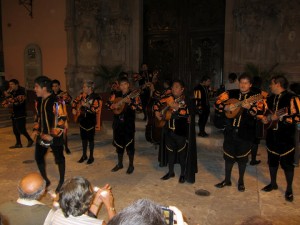 Groups of student musicians dressed in medivel European outfits play songs and lead tourists through the narrow alleys of Guanajuato. The experience is called a callejoneada, translated as something like alley-ing. The songs were mostly well known Mexican songs. Everyone around us was singing along. The estudiatinas would stop and tell a story in various plazas throughout the route. In one plaza we were taught to drink from a porrón, a Spanish wine decantor. We had learned from our friends in Spain a couple of years ago.
Groups of student musicians dressed in medivel European outfits play songs and lead tourists through the narrow alleys of Guanajuato. The experience is called a callejoneada, translated as something like alley-ing. The songs were mostly well known Mexican songs. Everyone around us was singing along. The estudiatinas would stop and tell a story in various plazas throughout the route. In one plaza we were taught to drink from a porrón, a Spanish wine decantor. We had learned from our friends in Spain a couple of years ago.  I thought I knew how to do it but ended up spilling apple juice down my front. Hank didn’t spill a drop. The estudiantes then led us to yet another plaza and pulled Cat out of the crowd to dance along with several other women. They played a song about a rooster, and my daughter had to flap her elbows like a chicken. We didn’t understand the words of the song, but we laughed out loud. The tour ended at the Callejón del Beso, or the Alley of the Kiss. Bill and I kissed in the alley, guaranteeing us years more of wedded bliss.
I thought I knew how to do it but ended up spilling apple juice down my front. Hank didn’t spill a drop. The estudiantes then led us to yet another plaza and pulled Cat out of the crowd to dance along with several other women. They played a song about a rooster, and my daughter had to flap her elbows like a chicken. We didn’t understand the words of the song, but we laughed out loud. The tour ended at the Callejón del Beso, or the Alley of the Kiss. Bill and I kissed in the alley, guaranteeing us years more of wedded bliss.
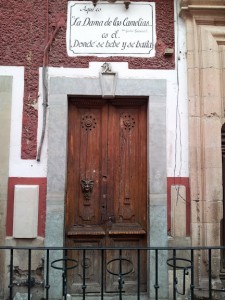 Dancing is part of the music. Salsa music reigns in a couple of bars in Guanajuato. There the atmosphere is mellow. Many of the people in Guanajuato really know what they’re doing. Their feet follow the rhythm: 1-2-3…5-6-7 with smooth, subtle steps. Their hips follow the rhythm as well but in a much wider path. The women dance better in heels, but no one is dressed to the nines. Bill and I tried to learn, taking a couple of lessons. It didn’t work. We did enjoy sitting at the tables, watching the dancers, swaying with the music, and drinking our palomas.
Dancing is part of the music. Salsa music reigns in a couple of bars in Guanajuato. There the atmosphere is mellow. Many of the people in Guanajuato really know what they’re doing. Their feet follow the rhythm: 1-2-3…5-6-7 with smooth, subtle steps. Their hips follow the rhythm as well but in a much wider path. The women dance better in heels, but no one is dressed to the nines. Bill and I tried to learn, taking a couple of lessons. It didn’t work. We did enjoy sitting at the tables, watching the dancers, swaying with the music, and drinking our palomas.
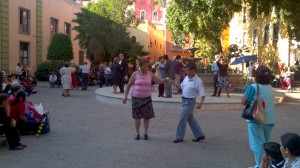 The salsa music wasn’t just for the bars. On Fridays a group of seniors gathered to dance at the Jardin Reforma. The music was recorded but the DJ was live. We watched as maybe 10 couples all over 70 years graced the plaza with their dance steps. Some of the men still had it, leading their ladies, hopping, skipping, and sliding. At the end of the songs the DJ encouraged us onlookers to applaud for the dancers. I clapped enthusiastically.
The salsa music wasn’t just for the bars. On Fridays a group of seniors gathered to dance at the Jardin Reforma. The music was recorded but the DJ was live. We watched as maybe 10 couples all over 70 years graced the plaza with their dance steps. Some of the men still had it, leading their ladies, hopping, skipping, and sliding. At the end of the songs the DJ encouraged us onlookers to applaud for the dancers. I clapped enthusiastically.
 We also got to see two symphony concerts. The university symphony plays every Friday night. The kids and I went to see a group of musicians playing music from the renaissance. A street musician moved in down the road from us and played the same Beatles songs on the street every day with his guitar case begging for pesos. Cat and I had drinks (only mine had tequila) at a bar just to listen to the band. Bill and I even visited the disco recommended by our flaming, round, works-at-night-as-a-lawyer Spanish teacher. But there was no music there. Just a bass line with 20-somethings dressed to kill and barely tapping their toes. The songs that were blaring were just noise as a backdrop to the pickup scene.
We also got to see two symphony concerts. The university symphony plays every Friday night. The kids and I went to see a group of musicians playing music from the renaissance. A street musician moved in down the road from us and played the same Beatles songs on the street every day with his guitar case begging for pesos. Cat and I had drinks (only mine had tequila) at a bar just to listen to the band. Bill and I even visited the disco recommended by our flaming, round, works-at-night-as-a-lawyer Spanish teacher. But there was no music there. Just a bass line with 20-somethings dressed to kill and barely tapping their toes. The songs that were blaring were just noise as a backdrop to the pickup scene.
And noise is part of the Guanajuato experience. In the mornings the roosters crow and dogs bark. Strong men who carry water jugs or gas tanks yell out their wares, “Agua” or “Gas”, throughout the day. But it’s the music that is the noise that makes the town special. There was music day and night, though mostly at night, all night. The music would sometimes wake me up. And I would smile as I drifted back to sleep, serenaded by the music of Mexico. Thank God I couldn’t hear the disco.